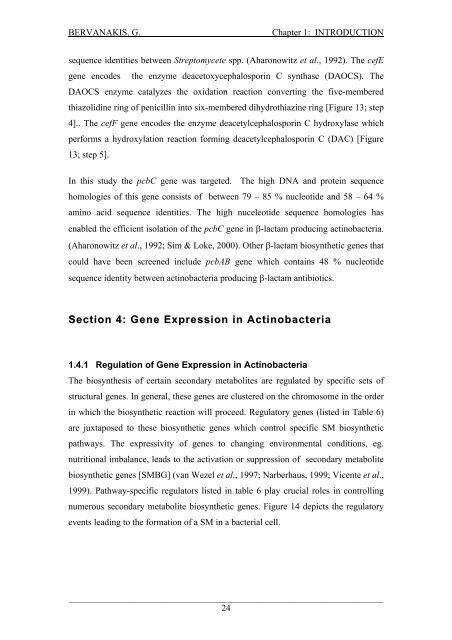Detection and Expression of Biosynthetic Genes in Actinobacteria ...
Detection and Expression of Biosynthetic Genes in Actinobacteria ...
Detection and Expression of Biosynthetic Genes in Actinobacteria ...
You also want an ePaper? Increase the reach of your titles
YUMPU automatically turns print PDFs into web optimized ePapers that Google loves.
BERVANAKIS, G.Chapter 1: INTRODUCTIONsequence identities between Streptomycete spp. (Aharonowitz et al., 1992). The cefEgene encodes the enzyme deacetoxycephalospor<strong>in</strong> C synthase (DAOCS). TheDAOCS enzyme catalyzes the oxidation reaction convert<strong>in</strong>g the five-memberedthiazolid<strong>in</strong>e r<strong>in</strong>g <strong>of</strong> penicill<strong>in</strong> <strong>in</strong>to six-membered dihydrothiaz<strong>in</strong>e r<strong>in</strong>g [Figure 13; step4].. The cefF gene encodes the enzyme deacetylcephalospor<strong>in</strong> C hydroxylase whichperforms a hydroxylation reaction form<strong>in</strong>g deacetylcephalospor<strong>in</strong> C (DAC) [Figure13; step 5].In this study the pcbC gene was targeted. The high DNA <strong>and</strong> prote<strong>in</strong> sequencehomologies <strong>of</strong> this gene consists <strong>of</strong> between 79 – 85 % nucleotide <strong>and</strong> 58 – 64 %am<strong>in</strong>o acid sequence identities. The high nuceleotide sequence homologies hasenabled the efficient isolation <strong>of</strong> the pcbC gene <strong>in</strong> β-lactam produc<strong>in</strong>g act<strong>in</strong>obacteria.(Aharonowitz et al., 1992; Sim & Loke, 2000). Other β-lactam biosynthetic genes thatcould have been screened <strong>in</strong>clude pcbAB gene which conta<strong>in</strong>s 48 % nucleotidesequence identity between act<strong>in</strong>obacteria produc<strong>in</strong>g β-lactam antibiotics.Section 4: Gene <strong>Expression</strong> <strong>in</strong> Act<strong>in</strong>obacteria1.4.1 Regulation <strong>of</strong> Gene <strong>Expression</strong> <strong>in</strong> Act<strong>in</strong>obacteriaThe biosynthesis <strong>of</strong> certa<strong>in</strong> secondary metabolites are regulated by specific sets <strong>of</strong>structural genes. In general, these genes are clustered on the chromosome <strong>in</strong> the order<strong>in</strong> which the biosynthetic reaction will proceed. Regulatory genes (listed <strong>in</strong> Table 6)are juxtaposed to these biosynthetic genes which control specific SM biosyntheticpathways. The expressivity <strong>of</strong> genes to chang<strong>in</strong>g environmental conditions, eg.nutritional imbalance, leads to the activation or suppression <strong>of</strong> secondary metabolitebiosynthetic genes [SMBG] (van Wezel et al., 1997; Narberhaus, 1999; Vicente et al.,1999). Pathway-specific regulators listed <strong>in</strong> table 6 play crucial roles <strong>in</strong> controll<strong>in</strong>gnumerous secondary metabolite biosynthetic genes. Figure 14 depicts the regulatoryevents lead<strong>in</strong>g to the formation <strong>of</strong> a SM <strong>in</strong> a bacterial cell._____________________________________________________________________24















